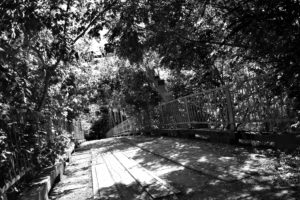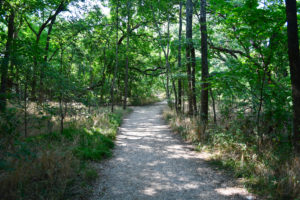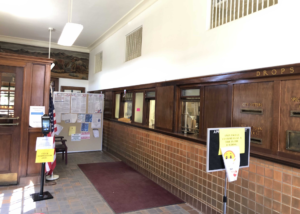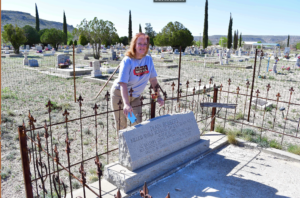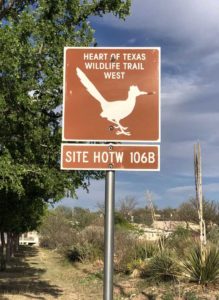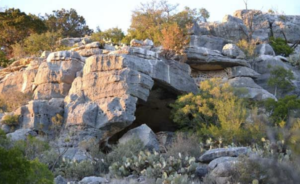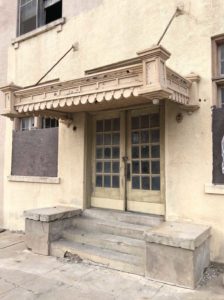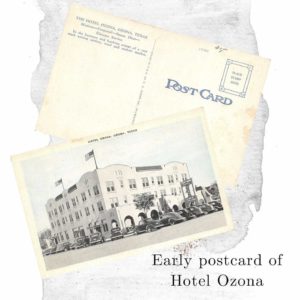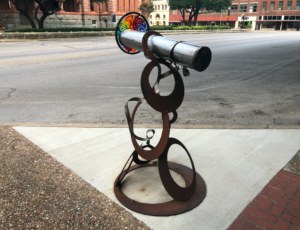Category: History
San Antonio’s Haunted Black Swan Inn


 Have you ever heard of San Antonio’s Black Swan Inn? Sounds elegant, doesn’t it? The 150-year-old Greek Revival named after Shakespeare’s favorite bar looks like an iconic Southern mansion. It’s now a popular venue for weddings, parties and even memorials but the dark past of the home and the land that it sits on has given it a reputation as one of the most haunted places in the state.
Have you ever heard of San Antonio’s Black Swan Inn? Sounds elegant, doesn’t it? The 150-year-old Greek Revival named after Shakespeare’s favorite bar looks like an iconic Southern mansion. It’s now a popular venue for weddings, parties and even memorials but the dark past of the home and the land that it sits on has given it a reputation as one of the most haunted places in the state.
You’ll probably need help from an app or map to find the home, which is situated along Salado Creek and nestled under a canopy of ancient trees.
The bloody 1842 Battle of Salado occurred on the property between General Adrian Woll, Sam Houston and their troops and the less successful Mexican troops who were fighting for control of the area. A total of 60 men lost their lives on the hill, just 20 years before the mansion was built on the same soil.
 The current owner moved her family into the mansion in 1990 and operated her Victorian garment company from the extra space. Soon the family heard repeated door slammings, saw a “shadow man” who sometimes pinched the children hard enough to cause bruises and had to admit they weren’t the only “residents” at the Inn.
The current owner moved her family into the mansion in 1990 and operated her Victorian garment company from the extra space. Soon the family heard repeated door slammings, saw a “shadow man” who sometimes pinched the children hard enough to cause bruises and had to admit they weren’t the only “residents” at the Inn.
Eight or more spirits are said to roam the house and land, including a Confederate soldier, former owners (one of whom hung himself . . . or was murdered, depending on who you ask), and a blonde-haired little girl.
 When I was invited to speak at a paranormal conference at the home a couple of years ago I enjoyed touring the interior, which is appropriately decorated and adorned with a heavy-hand. Victorian did love their “stylish clutter,” after all. The home needs quite a lot of work, but it’s easy to appreciate her beauty even through the chipping paint.
When I was invited to speak at a paranormal conference at the home a couple of years ago I enjoyed touring the interior, which is appropriately decorated and adorned with a heavy-hand. Victorian did love their “stylish clutter,” after all. The home needs quite a lot of work, but it’s easy to appreciate her beauty even through the chipping paint.
 One of the most popular spots inside the house for the local “ghost hunters” was a small closet off the main parlor. The interior was painted black and a chair and antique mirror were set inside. The locals told me that if you sit in the chair – in the dark – and stare into the mirror, the spirits can communicate directly with you.
One of the most popular spots inside the house for the local “ghost hunters” was a small closet off the main parlor. The interior was painted black and a chair and antique mirror were set inside. The locals told me that if you sit in the chair – in the dark – and stare into the mirror, the spirits can communicate directly with you.
No, I didn’t “experience” anything while I was at the Black Swan, but perhaps I was just too distracted thinking about the talk I was about to give to the crowd.
If you’d like to see if you can detect anything otherworldly for yourself, the Black Swan Inn regularly hosts the “Haunted Cocktail Hour” and other events that are open to the public.
Are you brave enough to visit after dark?
Walk with the Ghosts in Jefferson
It’s getting to be that fabulously spooky time of year! Halloween is just one month away, so I want to share one of my favorite ghostly activities for families, friends, or – if you dare – all by yourself.
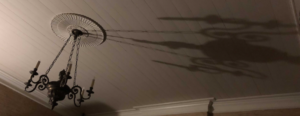 I’m often asked by the people who take my ghost tours in Galveston if I take the same type of tours when I travel. You bet! These type of tours are a fun way to explore the local communities and their folklore…whether or not you’re a “believer.” There are a lot of ghost tours in the Lone Star State but hands-down my favorite tour to TAKE is the Historic Jefferson Ghostwalk.
I’m often asked by the people who take my ghost tours in Galveston if I take the same type of tours when I travel. You bet! These type of tours are a fun way to explore the local communities and their folklore…whether or not you’re a “believer.” There are a lot of ghost tours in the Lone Star State but hands-down my favorite tour to TAKE is the Historic Jefferson Ghostwalk.
The small east Texas town of Jefferson is known as one of the most haunted towns in the state, and has no shortage of stories.
As darkness falls, tour-goers gather at the corner of the Kahn Hotel to meet tour guide and resident ghost story expert Jodi Breckenridge. No one knows the stories about this town as well as she does. Jodi gives the tours every Friday and Saturday night year-round…so, truth be known, you don’t have to wait for the Halloween season to enjoy one.
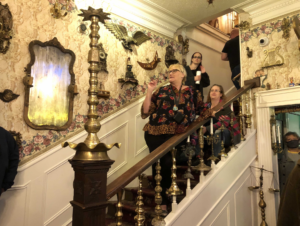 Every time I’ve been on her tour (yes, I’ve taken it more than once) there have been several others who are repeat customers. That may sound unusual, but each tour is a bit different depending on what does or doesn’t happen, and access to haunted locations. Those locations make this one of the best and most unique opportunities, because the tour goers will actually get to go inside a few! For each place Jodi shares a little bit of history and a few ghost stories.
Every time I’ve been on her tour (yes, I’ve taken it more than once) there have been several others who are repeat customers. That may sound unusual, but each tour is a bit different depending on what does or doesn’t happen, and access to haunted locations. Those locations make this one of the best and most unique opportunities, because the tour goers will actually get to go inside a few! For each place Jodi shares a little bit of history and a few ghost stories.
Take the word “walk” in the tour name seriously because you’ll be walking all around this charming town learning about the spirited residents of haunted hotels, houses, mansions, and bed and breakfasts, and businesses. You’ll even get to venture into the “Old Mill,” a darked antique market where attendees are encouraged to wander the aisles with the lights out. It always amazed me that I’ve never seen anyone knock anything over!
 Jodi encourages her customers to take photos along the way to see if they can “capture” something otherworldly, and shows a few spooky photos on her iPad from past tours.
Jodi encourages her customers to take photos along the way to see if they can “capture” something otherworldly, and shows a few spooky photos on her iPad from past tours.
Now I’m going to let you in on how to make the most of this experience…
 Twice a year, Jody hosts a “History, Haunts & Legends Paranormal Conference.” I usually go once a year, and am one of the guest speakers. It happens once in the fall and once in the spring. The ticket price includes your chance to meet and shop from authors of books of ghost stories, people who sell ghost hunting equipment, craftspeople who selling hauntingly unusual goods and more, in addition to hearing a day full of spooky-topic talks. I suggest buying a “VIP” ticket, so that you can also participate in a multi-location ghost hunt on the Saturday night of the conference. Private homes open up, each with a real ghost hunting team stationed with equipment, and you can go from location to location to participate. You’re sure to come away with fun stories to tell your family and friends.
Twice a year, Jody hosts a “History, Haunts & Legends Paranormal Conference.” I usually go once a year, and am one of the guest speakers. It happens once in the fall and once in the spring. The ticket price includes your chance to meet and shop from authors of books of ghost stories, people who sell ghost hunting equipment, craftspeople who selling hauntingly unusual goods and more, in addition to hearing a day full of spooky-topic talks. I suggest buying a “VIP” ticket, so that you can also participate in a multi-location ghost hunt on the Saturday night of the conference. Private homes open up, each with a real ghost hunting team stationed with equipment, and you can go from location to location to participate. You’re sure to come away with fun stories to tell your family and friends. 
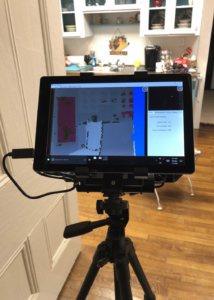
Want to stay somewhere haunted while you’re there?
Kahn Hotel (where I usually stay) is nice pretty low key, with a small coffee shop on the first floor. They openly admit they’re haunted, so they won’t think anything about it if you wander the halls with your “ghost meters.
The elegant old Excelsior Hotel – notoriously haunted, but whatever you do don’t mention that to the staff – who don’t like that reputation. Even Director Steven Spielberg has had experiences here!
Jefferson Hotel – purchased a couple of years ago, the new owners have turned it from a creaky old hotel with a haunted history into almost an amusement park for ghost and horror enthusiasts. Each room has a theme – some of them over the top.
Jefferson also has a variety of bed and breakfasts to enjoy, and many of them have paranormal stories of their own.
Now . . . are you ready to brave the ghosts of historic Jefferson?

Alpine’s Post Office with a View of the Past
Public art in the form of murals has become so popular in recent years, but they aren’t anything new. The next time you drive through a small town in Texas, stop into the local post office and take a look around. You might just find fine art where you’d least expect it.
Often referred to as “WPA murals,” examples of fine artwork created to enhance public buildings were actually a gift from the government to its citizens.
But, first thing’s first . . . the painting in Alpine wasn’t actually created as part of the Works Progress Administration. The WPA (I’m not going to drown you in details here) was created in 1935 as part of the “Second New Deal” to provide jobs for unemployed men during the depression. Most of the jobs were in construction, building roads, bridges, schools, parks, and airports. There were also artists recruited by the WPA, but they were given fairly free rein in the subjects they painted.
The murals I’d like to introduce you to were created by the Treasury Department Section of Painting and Sculpture which was created a year earlier than the WPA. It was later called the Section of Fine Arts. The goal of this program was to “secure for the Government the best art which this country is capable of producing.” Luckily for us, this art was contracted to decorate federally owned buildings, including hundreds of post offices around the county. That meant that everyone could enjoy fine art in their everyday lives, and the hope was that it would uplift the spirits of citizens during the hard times.
As one writer summed it up, “One boosted paychecks, and the other boosted morale.”
Professional artists (no students or amateurs could apply) entered competitions for Section assignments and were encouraged to visit the individual communities so their artwork would reflect local life or history. And unlike the WPA paintings, Section artists had to have their proposed artwork approved by committee and were limited in the subjects they were allowed to portray.

 One project of “The Section” placed artists in Civilian Conservation Corps (CCC) camps to create paintings of CCC work and life, and to make safety posters and decorate camp buildings for that project. The Section even provided sculptures to be exhibited at the New York World’s Fair in 1939.
One project of “The Section” placed artists in Civilian Conservation Corps (CCC) camps to create paintings of CCC work and life, and to make safety posters and decorate camp buildings for that project. The Section even provided sculptures to be exhibited at the New York World’s Fair in 1939.
By the end of the program (brought on by World War II) 1,047 murals and 268 sculptures had been created – which is pretty darn amazing. You can still find some of them today, but many have been lost due to building restorations, demolitions or public buildings being bought by private owners.
Anyway….
That’s why I went looking for an example in Alpine on a recent trip through West Texas. The subject especially spoke to me, since it portrays people reading. And nothing makes the heart of someone who writes books happier than seeing someone reading!
It was installed in 1940 inside the town’s new post office which was built by…you guessed it…the WPA.
The building on the corner of 6th Street and Avenue E served as the town’s post office through 2000, when it became the appraisal office for Brewster County. Since that building is open to the public, you can still see the mural in person during weekday business hours. You just have to walk a bit to the left and peer around a few light fixtures and bulletin boards!
 In 1939, a Spanish-American artist Jose Moya del Pino (1891-1969) living in San Francisco entered a TDSFA competition to paint a post office mural in San Antonio. His design depicting Sam Houston and the Alamo didn’t win, but he received a consolation assignment at the new Alpine building. The sketches he submitted with a “View of Alpine” did the trick that time.
In 1939, a Spanish-American artist Jose Moya del Pino (1891-1969) living in San Francisco entered a TDSFA competition to paint a post office mural in San Antonio. His design depicting Sam Houston and the Alamo didn’t win, but he received a consolation assignment at the new Alpine building. The sketches he submitted with a “View of Alpine” did the trick that time.
Jose couldn’t afford to travel to Texas to take a look at the town for ideas, so he asked for suggestions from the local postmistress, who told him about the local college, cowboys and scenery. From there he went to work painting this 4’ x 12’ work in oil on Masonite. He even used a neighbor who happened to own a hat and boots as his model for the cowboy.
When he completed the work in 1940, he accompanied it to Alpine for the installation and unveiling. The depiction of three locals relaxing with books on a hillside, with the Twin Sisters Peaks and Sul Ross State College (now University) in the background were a hit. The only question one local had was why a cowboy would be reading when the cattle were roaming unattended. (A valid question from someone who would probably never let that happen!)
I love the style and subject matter of this painting. It portrays an idealized but beautiful vision of our state, and it was well worth the stop whether you call it a Section or WPA creation.
Now, who’s ready to go out and hunt down a few more these treasures?
Looking for Buchel County’s Lock-up
Old, abandoned stone building? (I’m slowing down as I’m driving by.)
Bars on the door and windows? (I’m definitely stopping.)
My first guess that this had to be an old jail turned out to be right on target.
This lonely structure was the Buchel County Jail back when Marathon Texas was the county seat between 1887 and 1897.
 Wait . . . Buchel County? Nope, you’re not losing your marbles. There’s no Buchel County in the Lone Star State! Both Buchel and Foley Counties were absorbed into Brewster County – now the largest county in Texas – when their populations failed to flourish as well as expected.
Wait . . . Buchel County? Nope, you’re not losing your marbles. There’s no Buchel County in the Lone Star State! Both Buchel and Foley Counties were absorbed into Brewster County – now the largest county in Texas – when their populations failed to flourish as well as expected.
There was good reason to want a sturdy jail in town. West Texas was still a pretty wild place filled with cantankerous cowboys and outlaws back then.
But before the town had an actual building for that purpose, a windmill in the middle of North First Street was Marathon’s first jail. Drunks and other petty offenders were chained to one of its legs, and serious offenders were taken down the road to the Alpine jail.
Later, a one-room adobe house behind French’s Store served as a jail but, after several colorful escapes, locals decided that a better “calaboose” was in order, so this rock jailhouse was built.
It was constructed just south of the old Ritchey store in town, of rocks dug from a ledge on the northwest side of town. Talk about working with on-hand materials!
I can’t even imagine how hot it was inside this jail during the hot west Texas summer months!
When the Alpine jail was remodeled in 1901, their two old “cages” manufactured by Diebold Safe and Lock were brought to this location and installed. If you peer through the boars on the front door you can easily read the identifying word “L. T. Noyes – Houston, Texas” on the cell locking mechanism on the wall.
 Now this is pretty neat for fans of old-times Texas. Lucius T. Noyes was an agent for the Diebold Safe & Lock Company of Canton, Ohio. From his Houston office on the corner of Congress Avenue and San Jacinto Street he established a far reaching reputation in the world of “security.”
Now this is pretty neat for fans of old-times Texas. Lucius T. Noyes was an agent for the Diebold Safe & Lock Company of Canton, Ohio. From his Houston office on the corner of Congress Avenue and San Jacinto Street he established a far reaching reputation in the world of “security.” 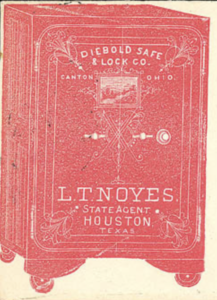
In addition to selling and installing over 50 county vaults and safes in Texas, Louisiana and surrounding states; and countless of the same for banks – he became quite a celebrity as a jail builder.
He sold the steel and iron fittings for the facilities and personally oversaw the construction and contract work for over 100 jails including this one, the impressive 1897 Fort Bend County Jail that now serves as the Richmond Police Department, the 1887 San Jacinto County Jail in Coldspring, the 1894 Glasscock County Jail in Garden City, and the 1886 Live Oak County Jail in Oakville.
I imagine he wasn’t too popular with the bad guys!
 Stealing a peek through the door and windows, it looks like there might have been a museum at Marthon’s little jail at some point, and the decaying remnants are admittedly a bit creepy. That mannequin will definitely take you off guard, but you can clearly see the jail cells, photos of what are probably local lawmen of the past on the wall, and broken display cases – whose contents I can only hope were safely removed before the damage. I’d love to see this “attraction” re-opened for a closer look.
Stealing a peek through the door and windows, it looks like there might have been a museum at Marthon’s little jail at some point, and the decaying remnants are admittedly a bit creepy. That mannequin will definitely take you off guard, but you can clearly see the jail cells, photos of what are probably local lawmen of the past on the wall, and broken display cases – whose contents I can only hope were safely removed before the damage. I’d love to see this “attraction” re-opened for a closer look.
You can find the former Buchel County Jail in Marathon behind the Ritchey Brothers building on South 2nd Street between Avenues C and D.
Searching for Outlaws in Sanderson
Have you ever search for an outlaw while on a vacation? They can be found in the most unexpected places, and it might not be as dangerous as it sounds.
If you recognize this famous photo, you might just be an Old West enthusiast like I am! It’s Butch Cassidy (bottom right), the Sundance Kid (bottom left) and the Wild Bunch, and is known as the “Fort Worth Five” photo.
That fellow sitting in the middle – known as “The Tall Texan” – was the subject of my search in Sanderson, Texas. He was a handsome guy, but didn’t always make good choices.
Ben Kilpatrick was born just east of San Angelo in 1874. He worked as a cowboy for several years before he became acquainted with Texas outlaws Sam and Tom Ketchum, and ended up riding with the Ketchum Gang.
 After a failed train robbery that ended in several of the members being caught, Kilpatrick fled to Robber’s Roost in Utah and joined the Wild Bunch. After some success, he and his girlfriend Laura Bullion made their way to St, Louis where they were arrested. Kilpatrick was seated to 15 years in prison for robbery, and Laura was sentence to five. After serving 31/2 years she was released, and went to Tennessee under an assumed name to make a new life.
After a failed train robbery that ended in several of the members being caught, Kilpatrick fled to Robber’s Roost in Utah and joined the Wild Bunch. After some success, he and his girlfriend Laura Bullion made their way to St, Louis where they were arrested. Kilpatrick was seated to 15 years in prison for robbery, and Laura was sentence to five. After serving 31/2 years she was released, and went to Tennessee under an assumed name to make a new life.
Kilpatrick, on the other hand, was released after 10 years and went immediately back to a life of crime. Bad decision…
Train number 7 of the Galveston, Harrisburg & San Antonio Railroad pulled out of Del Rio on the evening of March 12, 1912. It made a brief stop for water in Dryden, but as it pulled away from the station Kilpatrick and Ole Hobek ( a friend from his prison days) jumped aboard.
The masked robbers ordered the engineer to go to the first iron bridge east of Baxter’s Curve, about halfway to Sanderson. Once there the bandits ordered the train to stop and the passenger cars and caboose uncoupled from the engine, mail and baggage cars.
Leaving the passengers behind, they ordered the engine across the bridge and about a mile down the tracks, where the robbers had staged horses for their getaway.
Hobek kept a gun on the engineer while Kilpatrick went back to the baggage car with Wells Fargo Express agent David Trousdale. As they were making their way to the back of the car, Trousdale picked up a mallet from a shipment of frozen oysters and hid it in his clothing. (Frozen oysters…who would have thought THAT would be on the train?!)
 Kilpatrick was so busy filling a bag with $60,000 he didn’t see Trousdale sneak up to hit him over the head with the mallet. (Ouch!) The outlaw was killed with the one blow. Trousdale took the bandit’s gun and returned to the engine where he shot and killed Hobek just after midnight.
Kilpatrick was so busy filling a bag with $60,000 he didn’t see Trousdale sneak up to hit him over the head with the mallet. (Ouch!) The outlaw was killed with the one blow. Trousdale took the bandit’s gun and returned to the engine where he shot and killed Hobek just after midnight.
With the threat ended, the engineer backed up the train, re-coupled the passenger cars and proceeded to Sanderson.
The dead train robbers were held up for photographs, and later buried in a joint grave at Cedar Grove Cemetery in Sanderson. Trousdale, of course, was rewarded for his bravery.
Now known as the Baxter’s Curve Train Robbery (or the Sanderson Train Robbery), it was one of the last train robberies in the state.
In 2019, the mallet used in the incident, a photo of the dead bandits and the Wells Fargo accounts were sold at auction in Arizona for $64,900. It’s a bit ironic how close that amount is to the amount that the robber’s might have gotten away with, had there not been a quick thinking agent on board.
The train robbers’ grave was fairly easy to locate, surrounded by a decorative wrought iron fence and gate. The concrete slab that covers the plot was most likely poured in an effort to prevent gruesome souvenir hunters from robbing the grave.
As a taphophile, or someone who studies cemeteries, I’m always amazed at the stories that lie behind the stones if you only take time to investigate!
Ozona – The Biggest Little Town in the World
Biggest little town in the world, indeed!
Ozona is the only community in Crockett County which is the size of Delaware. Yep, the only one! It’s about an hour southwest of San Angelo, 398 miles from Houston and 347 miles from El Paso. Which makes it a pretty good jumping-off point for a lot of directions.
But before you zoom through, consider stopping for some of the unique things that Ozona has to offer. We scheduled an extra night on our trip to Big Bend to give us time to wander around and explore . . .and to give the ol’ accelerator-foot a break.







If you follow my blog or instagram account, you’ve probably figured out by now that I’m a sucker for historic courthouse buildings. I was happy to finally see this one in person.
The 1902 Second Empire courthouse of Crockett County – named after the legendary Davy Crockett – is the centerpiece of town. Designed by Oscar Ruffini, one of a pair of proliferate brother architects who kept busy populating Texas with their creations. Oscar also designed the Sutton County Courthouse, Tom Green County Courthouse and Ozona High School, and his brother Frederick Ernst designed the Concho County Courthouse, Bastrop County Courthouse, former Blanco County Courthouse (now restored) and the Millet Opera House in Austin.
 The courthouse was made from stone quarried on nearby property owned by the Crouch and Meyer families, and cost a whopping $30,000. In 1909 an arc light was added to the steeple to signal the sheriff (the Batman beacon comes to mind!) and guide travelers to town.
The courthouse was made from stone quarried on nearby property owned by the Crouch and Meyer families, and cost a whopping $30,000. In 1909 an arc light was added to the steeple to signal the sheriff (the Batman beacon comes to mind!) and guide travelers to town.
It was far more than a courthouse for Ozona and surrounding communities though, and served as a social center for cowboy dances, roundup celebrations, Christmas trees and box suppers (which reminds me of a particular scene from the musical Oklahoma!).
If the bull’s eye or “ox eye” circular moldings the mansard roof look like they’re missing something…they are! They were originally intended as a place for clock faces that were never installed. At one point in the past it bothered the locals enough to paint clocks in the features. When the courthouse was recently restored it was decided to leave them as is.
 A memorial statue of Davy Crockett stands nearby on the square. Placed on its base in 1938, it was carved from two slabs of granite weighing nearly 20 tons (well, after all – he WAS a heavyweight of Texas history!), and is inscribed with Crockett’s motto, “Be sure you are right, then go ahead.” Still seems like sound advice.
A memorial statue of Davy Crockett stands nearby on the square. Placed on its base in 1938, it was carved from two slabs of granite weighing nearly 20 tons (well, after all – he WAS a heavyweight of Texas history!), and is inscribed with Crockett’s motto, “Be sure you are right, then go ahead.” Still seems like sound advice.
“The Tie that Binds” is an emotional bronze stands at the center of the square just a few strides away from Davy to remind visitors of the perseverance of their pioneer ancestors. At life-and-a-quarter size, it makes quite an impression close up!
Just across the street is the former Hotel Ozona (not to be confused with the former Ozona Hotel . . . th ey could have used a bit more imagination, evidently). The three-story mission style inn was built in 1927 to attract tourists along the Old Spanish Trail. See more of my photos of this abandoned beauty and find out more about the OST here.
ey could have used a bit more imagination, evidently). The three-story mission style inn was built in 1927 to attract tourists along the Old Spanish Trail. See more of my photos of this abandoned beauty and find out more about the OST here.

I really appreciate visitors centers that are more than a room filled with pamphlets, and the Ozona Chamber of Commerce and Visitor Center (505 15th Street) is definitely worth a stop (even if it’s just to see this cocky granite Texas sporting a Stetson). The building is bright and welcoming, and the staff are versed in numerous local and area attractions that might peak your interest.
Across the parking lot is the Crockett County Interpretive Trail (free to visit) showcasing native plants that can b e found within 100 miles of Ozona. The short trail (like a small park) has over 200 plants representing over 75 species, each identified b
e found within 100 miles of Ozona. The short trail (like a small park) has over 200 plants representing over 75 species, each identified b y an inscribed stone. We were lucky to stop by in spring when several of the plants were showing off their blooms, but the display would be fascinating year round. Botanists and gardening fans will get a kick out of this detailed brochure of the exhibit.
y an inscribed stone. We were lucky to stop by in spring when several of the plants were showing off their blooms, but the display would be fascinating year round. Botanists and gardening fans will get a kick out of this detailed brochure of the exhibit.
Off-roaders will definitely want to venture out to the Escondido Draw Recreational Area, a 3,500 acre, 110 mile trail for all-terrain vehicles, dirt bikes and 4-wheel drives.
 After driving all day and seeing a bit of town, we were ready to sit down for a good meal, the The Hitching Post Steakhouse (1301 Old Highway 290) came highly recommended. Actually, on some days of the week like we arrived on it’s pretty much the only game in town, but that’s just fine.
After driving all day and seeing a bit of town, we were ready to sit down for a good meal, the The Hitching Post Steakhouse (1301 Old Highway 290) came highly recommended. Actually, on some days of the week like we arrived on it’s pretty much the only game in town, but that’s just fine.
We were a bit confused when we pulled into the parking lot filled with at least two dozen fire trucks and resc ue vehicles from all over Texas until we realized there was a firemen’s convention in town. But we definitely took that as a good sign, because let’s be honest – firemen know their food!
ue vehicles from all over Texas until we realized there was a firemen’s convention in town. But we definitely took that as a good sign, because let’s be honest – firemen know their food!
 The western theme, come-as-you-are restaurant probably hasn’t been redecorated much in the last few decades, which the faded photos of Old West Outlaws and cowhide on the wall, heavy wooden club chairs and indoor/outdoor carpeting will attest to – but you won’t care a bit once your food arrives. If you’re looking for good food at reasonable prices, The Hitching Post fits the bill.
The western theme, come-as-you-are restaurant probably hasn’t been redecorated much in the last few decades, which the faded photos of Old West Outlaws and cowhide on the wall, heavy wooden club chairs and indoor/outdoor carpeting will attest to – but you won’t care a bit once your food arrives. If you’re looking for good food at reasonable prices, The Hitching Post fits the bill.
A smoking room on one side has pool tables and the bar, and the other side of the building has non-smoking seating. An outdoor patio is also a good option for dining on fair weather days.
Thirsty for something stronger than tea? Be forewarned that the restaurant charges a $5 club fee to “join” to order alcohol.
 Since we hadn’t worked up big appetites we decided to split a couple of appetizers, and settled on marinated cube steaks and 1/2 order of fried mushrooms. The portions were generous and deliciously seasoned. Thank heaven the waitress suggested we choose a half order of mushrooms, since a full order would have fed half the firemen in the room.
Since we hadn’t worked up big appetites we decided to split a couple of appetizers, and settled on marinated cube steaks and 1/2 order of fried mushrooms. The portions were generous and deliciously seasoned. Thank heaven the waitress suggested we choose a half order of mushrooms, since a full order would have fed half the firemen in the room.
I’ll definitely go back to try the chicken fried steak next time I’m in town. The fact that they’re open until 11 p.m. makes it easy if one of your day trips from Ozona runs a bit longer than expected.
If you have a bit more time during your visit to Ozona, you might want to explore:
-
Crockett County Museum
-
Fort Lancaster State Historic Site in Sheffield
-
Caverns of Sonora (34 miles)

